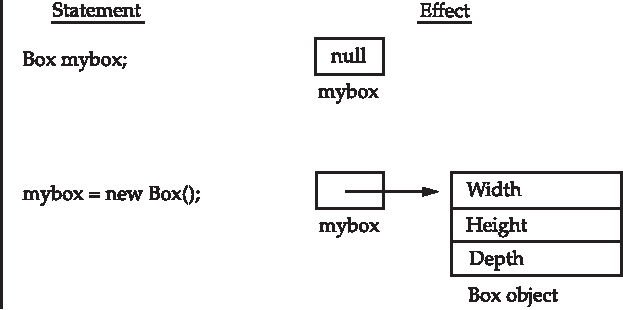FIGURE 6-1
Declaring an object
of type Box
Here, class-var is a variable of the class type being created. The classname is the name of the
class that is being instantiated. The class name followed by parentheses specifies the constructor
for the class. A constructor defines what occurs when an object of a class is created. Constructors
are an important part of all classes and have many significant attributes. Most real-world
classes explicitly define their own constructors within their class definition. However, if no
explicit constructor is specified, then Java will automatically supply a default constructor.
This is the case with Box. For now, we will use the default constructor. Soon, you will see
how to define your own constructors.
At this point, you might be wondering why you do not need to use new for such things
as integers or characters. The answer is that Java's primitive types are not implemented as
objects. Rather, they are implemented as "normal" variables. This is done in the interest of
efficiency. As you will see, objects have many features and attributes that require Java to treat
them differently than it treats the primitive types. By not applying the same overhead to the
primitive types that applies to objects, Java can implement the primitive types more efficiently.
Later, you will see object versions of the primitive types that are available for your use in
those situations in which complete objects of these types are needed.
It is important to understand that new allocates memory for an object during run time.
The advantage of this approach is that your program can create as many or as few objects as
it needs during the execution of your program. However, since memory is finite, it is possible
that new will not be able to allocate memory for an object because insufficient memory exists.
If this happens, a run-time exception will occur. (You will learn how to handle this and other
exceptions in Chapter 10.) For the sample programs in this topic, you won't need to worry
about running out of memory, but you will need to consider this possibility in real-world
programs that you write.
Let's once again review the distinction between a class and an object. A class creates a
new data type that can be used to create objects. That is, a class creates a logical framework
that defines the relationship between its members. When you declare an object of a class, you
are creating an instance of that class. Thus, a class is a logical construct. An object has physical
reality. (That is, an object occupies space in memory.) It is important to keep this distinction
clearly in mind.
Search WWH :


